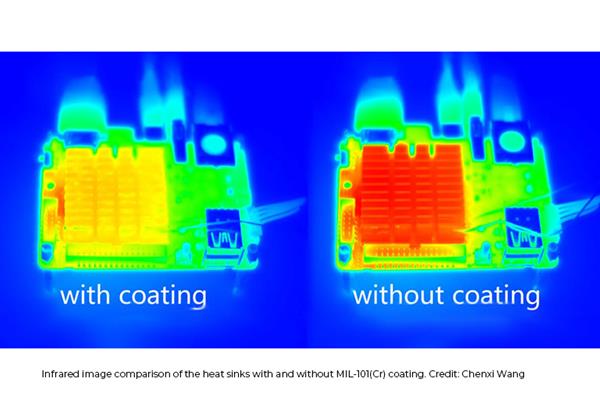
Researchers from Shanghai Jiao Tong University have developed a coating for electronics that releases water vapor to dissipate heat from running devices.
The growing need to keep mobile phones and other portable electronic devices cool spurred researchers from Shanghai Jiao Tong University, China, to devise an effective passive thermal management solution.
In order to achieve this, Prof. Ruzhu Wang, who studies refrigeration engineering at Shanghai Jiao Tong University, and his team were inspired by nature, where mammals can adjust their body temperature by sweating. Inspired by this sweating mechanism, they studied a group of porous materials that could absorb moisture from the air and release water vapor when heated. Among them, metal organic frameworks (MOFs) were the most promising because they could store a large amount of water and thus take away more heat when heated.
"The development of microelectronics puts great demands on efficient thermal management techniques, because all the components are tightly packed and chips can get really hot," says senior author Ruzhu Wang. "For example, without an effective cooling system, our phones could have a system breakdown and burn our hands if we run them for a long time or load a big application."
"Previously, researchers have tried to use MOFs to extract water from the desert air," adds Wang. "But MOFs are still really expensive, so large-scale application isn't really practical. Our study shows electronics cooling is a good real-life application of MOFs. We used less than 0.3 grams of material in our experiment, and the cooling effect it produced was significant."
The team selected a type of MOFs called MIL-101(Cr) for the experiment because of its good water-absorbing capacity and high sensitivity to temperature changes. They coated three 16-square-centimeter aluminium sheets with MIL-101(Cr) of different thicknesses — 198, 313, and 516 micrometres, respectively — and heated the them on a hot plate. The results showed that MIL-101Cr coating was able to delay the temperature rise of the sheets, and the effect increased with coating thickness. While an uncoated sheet reached 60°C after 5.2 minutes, the thinnest coating doubled the time and didn't reach the same temperature until 11.7 minutes. The sheet with the thickest coating reached 60°C after 19.35 minutes of heating.
"In addition to effective cooling, MIL-101(Cr) can quickly recover by absorbing moisture again once the heat source is removed, just like how mammals rehydrate and ready to sweat again," Wang says. "So, this method is really suitable for devices that aren't running all the time, like phones, charging batteries and telecommunications base stations, which can get overloaded sometimes."
To investigate the cooling effect of MIL-101(Cr) on actual devices, Wang and his team tested a coated heat sink on a microcomputing device. Compared to an uncoated heat sink, the coated one reduced the chip temperature by up to 7°C when the device was run at heavy workloads for 15 minutes.
The team plans to improve the material's thermal conductivity. "Once all the water is gone, the dried coating will become a resistance that affects devices' heat dissipation", explains first author Chenxi Wang. "Incorporating thermal conductive additives such as graphene into the material may help address the problem".
"By finding MOFs a practical application, we hope to increase the market demand for them and encourage more research on MOFs to bring down the costs", adds Ruzhu Wang.
The study was published on January 22, 2020 on the journal Joule and was supported by the Foundation for Innovative Research Groups of the National Natural Science Foundation of China.